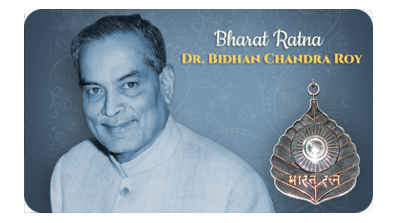https://meditropics.com/?page_id=885&preview=true
*Aakash Pandey
*Post Graduate Resident, Department of Medicine, LHMC

Born On: July 1, 1882
Born In: Bankipore, Patna, Bihar, India
Died On: July 1, 1962
Career: Physician, Politician
Dr. Bidhan Chandra Roy- A Big name in history, an eminent physician, an important freedom fighter for India and also the second Chief Minister of West Bengal.
Dr Bidhan Chandra Roy is fondly remembered through the celebration of the National Doctor’s Day on July 1 (his birth and death day) every year.
Childhood and Education
He completed his Intermediate in Arts from Presidency College, Calcutta, and his B.A. from Patna College, Bihar. After completing his graduation in Mathematics, Bidhan Chandra Roy applied for admission in both Bengal Engineering College and Calcutta Medical College. Being academically competent, he successfully qualified both but chose to pursue medical studies. Bidhan Chandra Roy left Patna in June 1901 to start his medical studies at the Calcutta Medical College. From a very young age, Bidhan Chandra used to lend a helping hand even to people who he was not directly related to.
Career
Dr Bidhan Chandra Roy joined the Provincial Health Service after his studies at Calcutta Medical College. In February 1909, Bidhan Chandra Roy left for England to continue further medical studies at St Bartholomew’s Hospital in London. By the year 1911, Bidhan Chandra Roy had completed both his M.R.C.P. and F.R.C.S. degrees in a span of only two years and three months. He returned to India in the year 1911 to join as faculty of Calcutta Medical College, subsequently shifting to the Campbell Medical School and then the Carmichael Medical College.
He used to donate large sums of money towards the establishment of medical colleges which would provide both medical education and medical aid to people. Several medical institutions in Calcutta, like the Jadavpur T.B. Hospital, the R.G. Kar Medical College, the Chittaranjan Seva Sadan, the Chittaranjan Cancer Hospital, the Victoria Institution and the Kamala Nehru Hospital were set up by Bidhan Chandra Roy.
Bidhan Chandra Roy entered politics in the year 1925. In the year 1928, Bidhan Chandra Roy was elected to the All-India Congress Committee. He became the leader of the Civil Disobedience Movement in Bengal in the year 1929.
After being elected to the All-India Congress Committee, Dr Bidhan Chandra Roy became a good friend of Mahatma Gandhi. When Gandhi had taken ill during the Quit India Movement of 1942, it was Dr B C Roy who treated him. In the year 1942, Bidhan Chandra Roy was elected as the Vice Chancellor of the University of Calcutta.
Dr. Bidhan Chandra Roy’s name was proposed by the Congress for the post of the Chief Minister of West Bengal. However, Bidhan Chandra Roy himself never wanted to assume office as the Bengal CM as he wanted to remain dedicated to his profession as a physician. It was on the insistence of Mahatma Gandhi that Bidhan Chandra Roy agreed to become the Chief Minister of West Bengal and was elected to the position on January 23, 1948. His 14 years as the second West Bengal CM was immensely successful.
Establishments
He played an instrumental role in the creation of two prestigious medical institutions in the country —
- The Indian Medical Association in 1928 and
- The Medical Council of India, of which he was the first president, between 1939 and 1945.
He also helped kickstart –
- Indian Institute of Mental Health,
- Infectious Disease Hospital and
- Kolkata’s first-ever postgraduate medical college.
Honors:
- Dr. Bidhan Chandra Roy was awarded the highest civilian award, the Bharat Ratna by the government of India on February 4, 1961.
- Dr. Bidhan Chandra Roy’s residence was converted into a nursing home named after his mother Aghorkamini Devi.
- The Government of India set up the Dr B C Roy Memorial Library and Reading Room for Children in the Children’s Book Trust in New Delhi in the year 1967.
- The B. C. Roy National Award was also started in the year 1976 to celebrate the contributions of individuals in the fields of medicine, politics, science, philosophy, arts and literature.